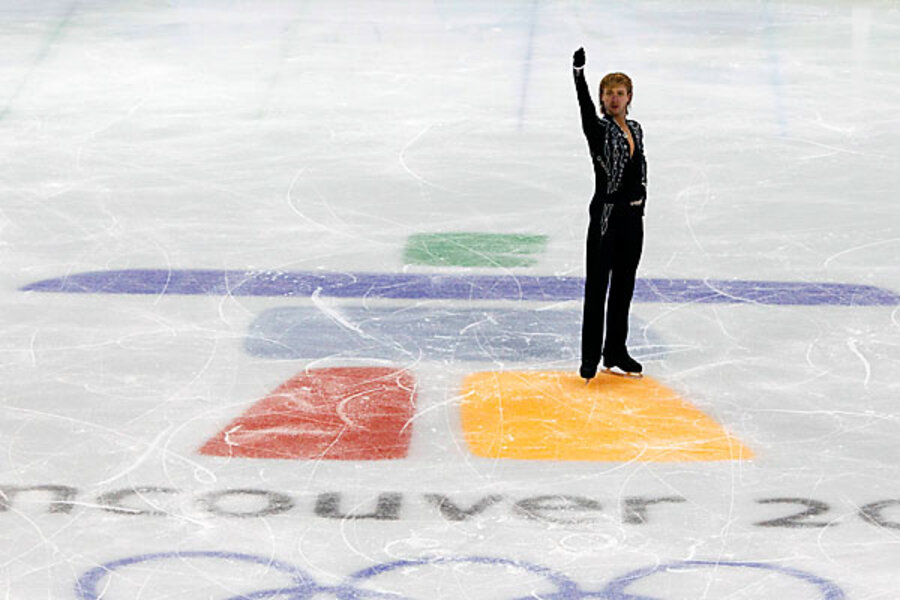Olympic men's figure skating: Tonight, it's all about the quad
Loading...
| Boston
Going into tonight's figure skating long program Yevgeny Plushenko, the steely Russian champion, is poised to do what no other man has done in figure skating in over 50 years: Repeat as Olympic champion.
And he's promised to do it by pushing the envelope, the same formula that propelled the American Dick Button to the podium in 1948 and 1952. The Russian's formula? Quads. Quads. And more quads. (Check out the quad video below)
Talking to reporters yesterday, he practically sneered at this main rival, the American Evan Lysacek's, unwillingness to take on figure skating's toughest maneuver.
Plushenko and the Japanese challenged DaisukeTakahashi said they'll go for it. Even Johnny Weir, not the best of leapers but needing to do something to force his way onto the podium from sixth place, is mulling pulling one out of the bag.
“Without quadruples, I don’t know, sorry, but it’s not men,” Plushenko said earlier this week. "It's not figure skating.”
The main American challenger Lysacek defended his reluctance to take on the jump. "I guess if you asked a speed-skater whether one stroke is more important than any other they would say no and I feel that way about my program. That each stroke I take, each jump is of equal importance. Sometimes it's easiest for us to forget about the simpler moves and take them for granted."
That might sound like an appeal to the judges to look at the total package, but if Plushenko lands his quads with authority and is clean otherwise, expect the gold to be his.
Though the first quadruple jump was completed in competition 22 years ago by the Canadian Kurt Browning and almost all of today's top men have completed quad's in practice, few have the power and balance to control the jump consistently in competition, which requires rotation rates upwards of 800 spins a minute.
"It’s not going to be just about quads," says Karen Cover, the archivist for the World FIgure Skating Museum and Hall of Fame in Colorado. "If Plushenko pulls a few [quads] but has a mistake here and there and someone else comes out and skates a clean program, that could cost him."
Former World Champion and three-time Olympian Todd Eldrige, writing for the New York Times, agrees with her: "I believe the judges will be looking for the best overall performance to take the title, not just who does the most difficult technical elements or who shows the greatest artistry." Still, he wrote: "The quad is a great trump card and if you removed it from the short program equation, your top three would most likely be in a different order."
The ongoing difficulty of the quad is something that sets skating apart from a sport like gymnastics, where the unthinkably brilliant moves of a generation ago often become the routine standard for top competitors. Snowboarding? Few would bet against Shaun White's "tomahawk," a first-time move he pulled of in the last of his Olympic winning runs Wednesday night, to be uncommon a decade from now.
But change in figure skating is, well, glacial. Traditionalist still grumble about the removal of compulsory figures -- the mind-numbing to watch and infuriating to master act of tracing perfect figure eights on a clean patch of ice -- after the 1992 Olympics.
And so we return to the evolution of figure skating's toughest jump.
When Button, who went on to become a peerless commentator on figure skating, who was tougher on the competitors that the current NBC stalwart Scott Hamilton, won in 1948 he did it with skatings' first double axel. In 1952, he followed up with the first triple -- a triple toe loop. Yet it took until the late 1970s for triples to become a standard part of the top men's repertoires.
In those years, the quad seemed liked a distant dream though some men were rumored to be working on it. This writer, who grew up in a figure skating family, remembers spooky speculation among the kids at the rink that the rotation required for a quad might even cause brain damage.
And then there were the complaints of "jumping beans" killing off the artistry of figure skating after Elaine Zayak won the 1982 world championship by rattling off six triples to overcome a 7th place deficit in the compulsory figures. After that competition, international skating officials adopted what came to be known as the "Zayak rule," which states that skaters won't be given credit for repeating the same triple (Four of Ms. Zayak's six triples were toe loops).
But the fans and sponsors loved it, and the way the compulsory figures could stand in the way of an athlete like Zayak contributed to their doom a decade later.
Now, Plushenko told reporters, it's his time.
"The future of figure skating is in the quad jumps," Plushenko said. "In the '80s, everybody was jumping the doubles... then the skaters started jumping triples. Then the triple axel. Then the quadruple. In the future, I think we need to make quad salchow, quad flip, quad lutz. Of course, we need transition, we need speed, we need steps. But I don't know. In all sports, they have new [improvements]. I think we stopped."





